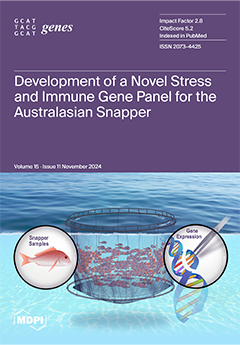Background/Objectives: MIR27A rs895819 polymorphism has emerged as a potential additional pharmacogenomic marker of fluoropyrimidine response. Current evidence on its potential effect on miR-27a expression, which represses DPD activity, leading to DPD deficiency and increased fluoropyrimidine-associated toxicity risk, is scarce and inconsistent. We have analyzed the effect of
MIR27A rs895819 polymorphism on miR-27a-3p plasma expression levels under different models of inheritance to contribute further evidence on its plausible biological role in miR-27a expression.
Methods: A total of 59 individuals with no medical history of cancer were included in this study.
MIR27A rs895819 genotyping and miR-27a-3p expression were analyzed by using predesigned TaqMan assays.
Results: The frequency of TT, TC, and CC genotypes was present at a prevalence of 50.8%, 44.1%, and 5.1%, respectively. Individuals carrying the CC genotype presented with decreased miR-27a-3p expression (0.422 fold-change versus TT,
p = 0.041; 0.461 fold-change versus TC,
p = 0.064), whereas no differences were present between TT and TC individuals (1.092 fold-change,
p = 0.718). miR-27a-3p expression was decreased in CC individuals under a recessive model of inheritance (0.440 fold-change,
p = 0.047). No differences were found in dominant (TT vs. TC+CC, 0.845 fold-change,
p = 0.471) or over dominant (TT+CC vs. TC, 0.990 fold-change,
p = 0.996) models of inheritance.
Conclusions: MIR27A rs895819CC genotype leads to severely reduced miR-27a-3p expression in plasma. Further study of this association is warranted in cancer patients to apply
MIR27A genotyping in therapeutics to identify fluoropyrimidine-treated patients who are at a decreased risk of experiencing fluoropyrimidine-induced severe toxicity.
Full article






